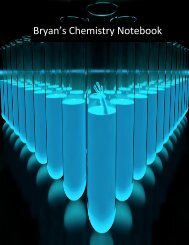You also want an ePaper? Increase the reach of your titles
YUMPU automatically turns print PDFs into web optimized ePapers that Google loves.
This would be a generic base:<br />
152<br />
XOH ---> X + + OH¯<br />
When acids and bases react according to this theory, they neutralize each other, forming water and a<br />
salt:<br />
HA + XOH ---> H2O + XA<br />
Keeping in mind that the acid, the base and the salt all ionize, we can write this:<br />
Finally, we can drop all spectator ions, to get this:<br />
H + + A¯ + X + + OH¯ ---> H2O + X + + A¯<br />
H + + OH¯ ---> H2O<br />
These ideas covered all of the known acids at the time (the usual suspects like hydrochloric acid,<br />
acetic acid, and so on) and most of the bases (sodium hydroxide, potassium hydroxide, calcium<br />
hydroxide and so on). HOWEVER, and it is a big however, the theory did not explain why ammonia<br />
(NH3) was a base. There are other problems with the theory also.<br />
III. Problems with Arrhenius' Theory<br />
1. The solvent has no role to play in Arrhenius' theory. An acid is expected to be an acid in any<br />
solvent. This was found to not be the case. For example, HCl is an acid in water, behaving in<br />
the manner Arrhenius expected. However, if HCl is dissolved in benzene, there is no<br />
dissociation, the HCl remaining as un-dissociated molecules. The nature of the solvent plays a<br />
critical role in acid-base properties of substances.<br />
2. All salts in Arrhenius' theory should produce solutions that are neither acidic or basic. This is<br />
not the case. If equal amounts of HCl and ammonia react, the solution is slightly acidic. If equal<br />
amounts of acetic acid and sodium hydroxide are reacted, the resulting solution is basic.<br />
Arrhenius had no explanation for this.<br />
3. The need for hydroxide as the base led Arrhenius to propose the formula NH4OH as the<br />
formula for ammonia in water. This led to the misconception that NH4OH is the actual base,<br />
not NH3.<br />
In fact, by 1896, several years before Arrhenius announced his theory, it had been recognized that<br />
characteristic base properties where just as evident in such solvents as aniline, where no hydroxide<br />
ions were possible.<br />
4. H + , a bare proton, does not exist for very long in water. The proton affinity of H2O is about 799<br />
kJ/mol. Consequently, this reaction:<br />
H2O + H + ---> H3O +<br />
happens to a very great degree. The "concentration" of free protons in water has been estimated to<br />
be 10¯130 M. A rather preposterous value, indeed.<br />
The Arrhenius theory of acids and bases will be fully supplanted by the theory proposed<br />
independently by Johannes and Thomas Lowry in 1923.




